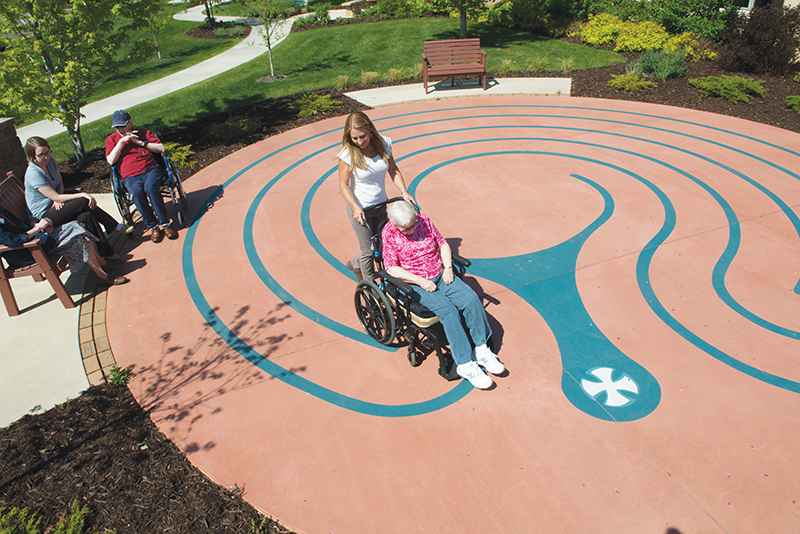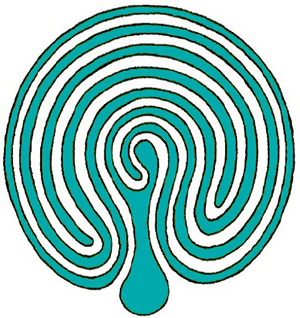BY: BECKY URBANSKI, Ed.D
At Benedictine Health Center at Innsbruck in New Brighton, Minn., one of the first things visitors to the long-term care center see is a large, flat maze close to the front entrance. On any given day, it is not unusual to see residents in walkers or wheelchairs, staff and family members or even neighbors quietly and slowly following the contemplative path. Called a labyrinth, it is part of the healing garden at this suburban Minneapolis care center.
A circular design found in almost every religious tradition over the past 4,000 years, a labyrinth can be seen in etchings on the walls of caves, in decorative tiles for floors, in basketry, pottery and coins as well as other items. Historically, patterns on the floor or on the ground that can be walked as a path or maze are called labyrinths. Labyrinths are used for meditation, dance, rituals, ceremonies and sometimes just for fun. Also considered a spiritual tool, a labyrinth can represent an individual's spiritual journey with its many unknown twists and turns and have an ultimate goal of reaching the center.
Today, labyrinths can be found at hospitals, long-term care centers, schools, prisons, retreat centers and many other locations. Studies have shown that a labyrinth walk can assist with stress reduction, problem-solving, self-healing, awareness, harmony, creativity and other personal improvements. Taking a few minutes to walk the labyrinth can bring calm to a frustrating day, help give clarity to a situation or simply allow someone to enjoy a beautiful day.
"There is no right or wrong way to walk a labyrinth," said Fran O'Connor, spiritual care director at Benedictine Health Center at Innsbruck. "We encourage our staff members to use the labyrinth with our residents and I often see our associates outside with an individual explaining what they are doing together."
The labyrinth at Benedictine Health Center at Innsbruck was dedicated in 2012 and is part of four major gardens at the organization. "It is integrated with the walking paths featuring flowers and native grasses," said Reid Hewitt, administrator/chief executive officer of the community. The design is based on a historical pattern found near the Baltic Sea and in northern European countries. Designed by Lisa Moriarty at Paths of Peace, the gentle turns of the labyrinth are suitable for people of varying abilities, including those using medical equipment. The colors of teal and tan were selected for their gentle and soothing qualities. Additionally, the particular shade of teal is recognizable as one of the primary identity colors for the organization.
"It is simply a beautiful outdoor location that is used to connect with others. We have invited our local neighbors to use the labyrinth as our health center is an important part of our community," said Hewitt.
BECKY URBANSKI is senior vice president, mission integration and marketing for Minnesota-based Benedictine Health System.
NOTE
Information for this article came from The Labyrinth Society, www.labyrinthsociety.org; Wikipedia, https://en.wikipedia.org/wiki/labyrinth; and interviews with Reid Hewitt and Fran O'Connor at Benedictine Health Center at Innsbruck in New Brighton, Minn.

Rolf Hagberg
HOW TO WALK A LABYRINTH
Pause at the entrance and breath slowly. Pray for awareness, an open mind and heart. Use this time to release your thoughts and concerns and unclutter your mind. Find a pace that is natural and comfortable. Use a mantra— repeat a word or phrase in rhythm with your pace. Let the walk unfold on its own. The center is a quiet place for rest. Stay as long as you wish. Journey out by re-tracing your steps with greater clarity, peace and serenity and connect the quiet center with the outside world.
Source: Fran O'Connor, spiritual care director, Benedictine Health Center at Innsbruck

A BLESSING FOR YOUR LABYRINTH WALK
May you meander the labyrinth's path
within the present moment of your life story.
May you step into the labyrinth with
your depth questions, sorrows or grief.
May you bring to the labyrinth
your dreams and joys, hopes or thanksgivings.
May your walk challenge and teach when needed,
and open your heartmind to possibilities.
May you explore in the labyrinth
your wisdom, courage, compassion and sincerity.
May your walk offer creative insights,
calm focus and a lift for your spirit.
May you relish the experience of the walk.
May you discover your essence of wellness,
as you step-by-step and turn-by-turn
dance this form of body, mind and spirit prayer.
Amen.
— Rev. Barbara Kellett